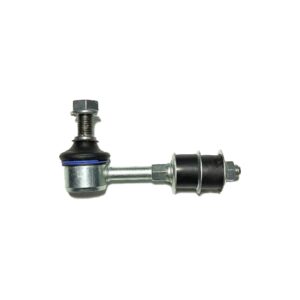A damaged or worn stabilizer bar, also known as a sway bar, can cause a number of symptoms or signs that something is wrong with your vehicle’s suspension system.
Here are some common signs of a damaged stabilizer bar:
Excessive body roll: One of the most common signs of a damaged stabilizer bar is excessive body roll when turning or cornering. This can make the vehicle feel unstable and may cause the suspension to bottom out or bounce excessively.
Clunking or rattling noises: If the stabilizer bar or its links are worn or damaged, you may hear clunking or rattling noises coming from your vehicle’s suspension. This may be especially noticeable when going over bumps or rough roads.
Uneven tire wear: A damaged stabilizer bar can cause uneven tire wear, as the suspension may not be properly aligned or balanced. This can lead to premature wear and tear on your tires, which can be costly to replace.
Poor handling or steering response: A damaged stabilizer bar can also cause poor handling or steering response, as the suspension may not be able to properly absorb bumps and dips in the road. This can make the vehicle feel unstable or unpredictable, especially at higher speeds.
Visible damage: If you notice visible damage to the stabilizer bar or its links, such as cracks, bends, or missing parts, China car stabilizer link Manufacturer it’s important to have the suspension system inspected and repaired as soon as possible. Driving with a damaged stabilizer bar can be dangerous and may lead to further damage to other components of the suspension system.
How can I inspect the stabilizer bar and its links for damage?
Inspecting the stabilizer bar and its links for damage is an important part of maintaining your vehicle’s suspension system. Here are the steps to follow to inspect the stabilizer bar and its links for damage:
Park the vehicle on a level surface: Make sure the vehicle is parked on a level surface and engage the parking brake.
Locate the stabilizer bar and its links: The stabilizer bar is usually located under the front or rear of the vehicle, depending on the make and model. The links connect the stabilizer bar to the suspension and are typically located near the wheels.
Inspect the stabilizer bar: Look for signs of damage to the stabilizer bar, such as cracks, bends, or rust. Make sure the bar is securely mounted to the frame of the vehicle and that there are no loose or missing bolts.
Inspect the stabilizer links: Check the stabilizer links for signs of wear or damage, such as worn or torn rubber bushings, loose or missing hardware, or bent or damaged links. Make sure the ball joints on each end of the links are secure and not worn or damaged.
Test the suspension: To further test the stabilizer bar and its links, push down on each corner of the vehicle and observe the movement of the suspension. If the suspension bounces excessively or feels loose, there may be a problem with the stabilizer bar or its links.
If you notice any signs of damage or wear during your inspection, it’s important to have the stabilizer bar and its links replaced or repaired as soon as possible to ensure safe and reliable operation of your vehicle.
